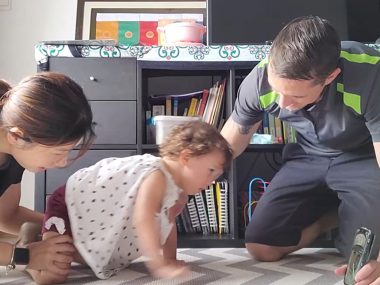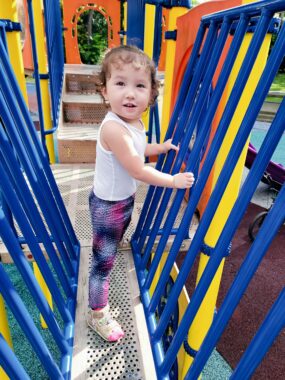The daily schedule of an AADC deficiency caregiver
How we've structured our routine to support our daughter's growth
Written by |

When our daughter, Rylae-Ann, was diagnosed with aromatic l-amino acid decarboxylase (AADC) deficiency, my wife, Judy, and I didn’t just adjust our schedule; we threw it out and built a brand-new one from scratch. Coffee-fueled and determined, we reshaped our daily lives to meet her needs while (mostly) keeping our sanity intact.
Many parents have asked us, “What does your schedule actually look like?” The truth is it has evolved over time, but here’s an overview of how we’ve structured our days to support Rylae-Ann’s growth, learning, and independence. It involves a lot of therapy, teamwork, and creative problem-solving!
Morning

Rylae-Ann’s parents work as a team to support her in developing her core, arm, and leg muscles. (Courtesy of Richard E. Poulin III)
Rylae-Ann is an early bird. Before receiving gene therapy, she never slept through the night, which meant waking up felt like surviving a night shift as a sleep-deprived security guard. But no matter how groggy we were, the first order of business was physical therapy (PT).
In the early days, this meant teaching her to crawl, which required both of us to roll out of bed like a synchronized team. Once she mastered crawling, I took over most of the PT sessions, allowing Judy to prepare breakfast because nothing motivates a toddler like food.
Breakfast time doubled as an occupational therapy (OT) session. Back when Rylae-Ann was a baby, I’d hold her upright while Judy carefully fed her to reduce the risk of aspiration. As Rylae-Ann grew, Judy became a master puppeteer, guiding her hand to use a fork and spoon. It may have looked like a high-stakes game of “who’s really in control here,” but those sessions helped her become the independent eater she is today.
Then, we were off to work, leaving our nanny with a treasure trove of fun activities, songs, and books. In the beginning, it felt like we were entertaining an audience of one who responded with no feedback or movement. But after gene therapy, we saw a payoff. She’d been absorbing everything like a tiny, determined sponge.
Afternoon
Afternoons started with a nap. Sleep wasn’t just rest; it was like pressing a reset button to help reduce the severity of Rylae-Ann’s oculogyric crises, which are eye movement disorders. She’d sleep for about two hours, which gave the nanny a golden window to take a well-deserved nap herself.
As Rylae-Ann grew, her nap phase ended. But the afternoon still revolved around fueling her little body with healthy snacks and supplements, followed by more songs, books, and activities to keep her engaged. We believe in the power of holistic learning — language, movement, and play all rolled into one.
Evening

The park was the perfect place to work on therapy goals while also having fun. (Photo by Richard E. Poulin III)
As teachers, our workday ended around 3:30 p.m., which meant a dramatic race home. Our nanny met us downstairs with Rylae-Ann, fully packed and ready for the next adventure — therapy sessions.
Throughout the week, her schedule was a mix of PT, OT, and speech and horse therapy. These sessions weren’t just about meeting milestones; they were mini-victories, each bringing her closer to independence. Plus, they gave us homework to continue our progress at home. We took meticulous notes and always left with a plan for the week.
After therapy, Rylae-Ann was usually exhausted, which meant she snoozed in the taxi home. By the time we arrived, dinner was ready. Mealtime was a replay of breakfast — teamwork, therapy goals, and a few messier-than-expected moments.
Then, it was time for movement. Whether it was at the pool or the park, evenings became the perfect opportunity to work on walking while sneaking in a little playtime. Eventually, these playful exercises helped her take independent steps.
We ended the night with a family stroll before the bedtime routine kicked in. After bath time, Judy did a baby massage while I had the bedtime story duties. If we were lucky, we’d be done before completely passing out ourselves.
Weekends
Even on weekends, we stuck to our schedule. It provided predictability and comfort for Rylae-Ann. But weekends were special because we added new experiences: a museum, the beach, or an adapted family outing. We quickly learned that not every typically “fun” location was accessible or enjoyable for our daughter, so we got creative, choosing destinations that worked for all of us.
In the beginning, this schedule felt overwhelming. It was like juggling flaming torches while riding a unicycle. Over time, it became second nature and enjoyable. The key isn’t to copy our schedule exactly, but to create a routine that maximizes your child’s goals while making space for joy, adventure, and family time.
Your routine might look different, and that’s OK! The goal is to blend therapy with everyday moments, making progress feel natural rather than forced. Most importantly, remember you’re not alone in this journey. With patience, flexibility, and a bit of humor, you’ll find a rhythm that works for your family.
Note: AADC News is strictly a news and information website about the disease. It does not provide medical advice, diagnosis, or treatment. This content is not intended to be a substitute for professional medical advice, diagnosis, or treatment. Always seek the advice of your physician or other qualified health provider with any questions you may have regarding a medical condition. Never disregard professional medical advice or delay in seeking it because of something you have read on this website. The opinions expressed in this column are not those of AADC News or its parent company, Bionews, and are intended to spark discussion about issues pertaining to aromatic l-amino acid decarboxylase deficiency.





Leave a comment
Fill in the required fields to post. Your email address will not be published.